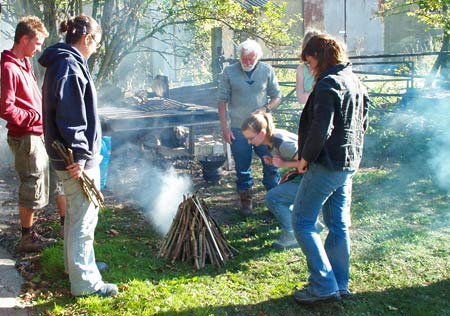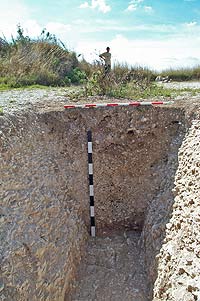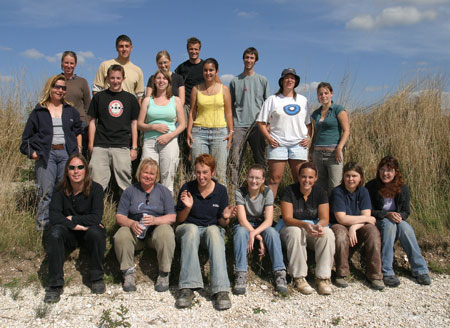The fifth day of this year’s training excavation, and the last day for this week’s volunteers, began with the arrival of several visitors. The first was John Winterbottom, our prehistoric potter, who had come to teach us how to fire pottery in a bonfire kiln. Three fires were lit by stacking wood on hot coals, placing the pottery on top and then building a ‘wigwam’ of sticks around this. The hot coals ignited the wood and within fifteen minutes the fires had burnt themselves down to embers leaving our pottery fired in the ashes.

 During this workshop, Wessex Archaeology’s photographer Elaine Wakefield arrived and began taking some professional photographs of the demonstration, and later some of the team hard at work. Surveyor Doug Murphy, also of WA, came in the morning too, in order to map the site using a GPS system and to train three volunteers in GPS survey. This will produce a computerised map of the site and should help us to see any patterns made by our postholes, and thus to understand them better. Finally Tom Goskar, from Wessex Archaeology’s IT department, came to the site to record a podcast with the team which will be accessible on this site soon.
During this workshop, Wessex Archaeology’s photographer Elaine Wakefield arrived and began taking some professional photographs of the demonstration, and later some of the team hard at work. Surveyor Doug Murphy, also of WA, came in the morning too, in order to map the site using a GPS system and to train three volunteers in GPS survey. This will produce a computerised map of the site and should help us to see any patterns made by our postholes, and thus to understand them better. Finally Tom Goskar, from Wessex Archaeology’s IT department, came to the site to record a podcast with the team which will be accessible on this site soon.
Following the firing of the pottery our team returned to the site. Work continued on postholes begun yesterday and at the final count 20 were either fully recorded or were excavated ready for recording next week. Other team members worked on the ditch in the west of the site. Slots excavated in previous years were re-opened and excavation continued in them. One large slot in the centre of the ditch, which was fully excavated last year, was re-opened in order for us to take a column of snail samples through the north facing section. This should help us to understand the environment around the ditch when it was filled in. This slot also revealed antler-pick marks in the chalk at the base of the ditch that we are interested in fully recording.
Finally in the afternoon Martin led an extended tour of Down Farm and its archaeology which was enjoyed by most of the team. However, a few of our excavators were so taken by fieldwork that they decided to stay on site to continue excavation.
